Digital transformation is taking over every industry by making it secure, transparent, and accessible. Even though the traditional voting system is convenient, it is demanding for security, accessibility, and transparency since there is susceptibility to manipulation and other challenges.
In this situation, creating a blockchain-based electronic voting system or similarly advanced political apps will work great by making the whole democratic process secure and transparent.
If you are planning to turn this vision into reality and to offer voters a better electoral experience, it can be a challenging path. This blog will explain everything about the blockchain-based voting system and will additionally break down its development process.
What is a Blockchain-Based Electronic Voting System?
Before you learn how to develop a blockchain-based electronic voting system, let’s understand this system briefly. The blockchain-based electronic voting system is the best alternative to the traditional voting system, which is technically more secure, more transparent, and more reliable.
The traditional voting system stores the votes of individuals in a centralized database, which is easy to decrypt by anyone. But this new technology, blockchain, uses a decentralised peer-to-peer network that stores and processes votes in a distributed ledger, which securely encrypts every vote of the individuals.
Thus, the blockchain-based electronic voting system ensures that every vote is cast securely, transparently counted, and cannot be tampered with or deleted.
By using the blockchain voting system, the whole voting process can be made more trustworthy and efficient. This modern system can effectively address the challenges associated with older generations of electronic voting systems.
Benefits of Blockchain Voting Systems
So, now you know about the electronic voting system backed by smart blockchain software.
But before you move forward and learn about its development process, you should know about the benefits of developing online voting systems and integrating blockchain software. This will help you in successfully implementing this secure and modern solution for the election.
Let’s explain the benefits of an electronic voting system powered by blockchain in detail :
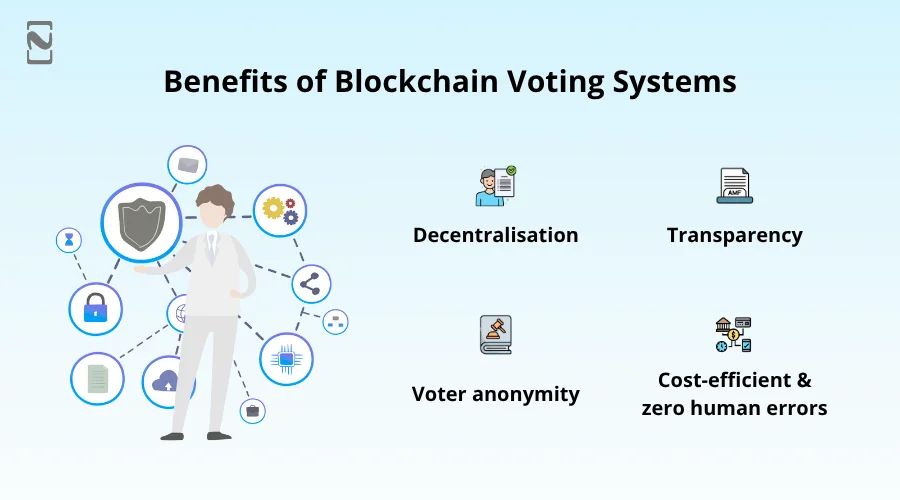
► Decentralisation
Blockchain in fintech for electronic voting systems keeps the integrity of the voting records by decentralizing the databases across thousands of nodes.
This will remove the problem of tamper-proof transactions that come with the traditional voting system. So, now it will be possible for the election commission to block manipulation risk with blockchain.
► Transparency
The best thing about implementing blockchain-based electronic voting systems is that votes can only be counted on a permitted ledger.
Additionally, it builds confidence among voters, as the blockchain system ensures they do not reveal their identity while auditing. Thus, it eliminated the need to trust the central authority but built trust into the system.
► Voter Anonymity
The best thing about blockchain is that it protects the electronic voting system database, which consists of the personal information of the voters.
This leads to safeguarding the voter’s anonymity, and it gives overall security from voter fraud during the election. Thus, blockchain in the voting system offers full privacy without sacrificing transparency.
► Cost-Efficient & Zero Human Errors
The traditional voting system is costlier, since it needs physical ballots, polling booths, and staff to peacefully carry out the whole election process.
The manual operational expenses of the voting process can be controlled by the automatic blockchain technology. Further, automating the voting process with pre-processing smart contracts reduces human errors.
Development Process of a Blockchain-Based Electronic Voting System
After reading about the benefits of the blockchain voting system, you must be convinced to create an online voting system. This will not only be a good investment for your business but will also help a large number of voters to access voting rights.
To help you understand how it can be created, we have shared with you the blockchain app development process below.
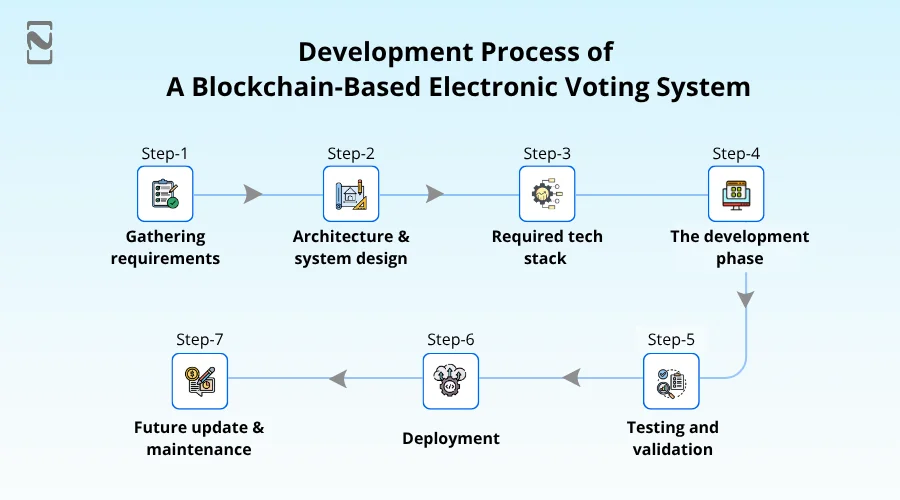
1. Gathering Requirements
First things, you should gather information or research about the requirements. This is why there is a need to create a blockchain-based voting system.
So start with defining objectives like voters’ privacy, end-to-end encryption, and fraud prevention. Additionally, ensure your system is compatible with national electoral laws and data protection regulations.
2. Architecture & System Design
Next comes creating the design of the blockchain voting system, where it’s crucial to select the blockchain network, architecture, core components, and security design.
Choose the appropriate blockchain network, like Ethereum, Hyperledger, etc. Next, for architecture, consider using Layer 2 solutions or SD-Edge for scalability.
Select from core components like voter registration module, authentication & authorisation system, voting interface (web/app), blockchain network layer, etc.
For security design, you should implement zero-knowledge proofs, homomorphic encryptions, or ring signatures for privacy, and also use smart contracts to make voting and tallying easy.
3. Required Tech Stack
Choosing the right mobile tech stack is important to make an electronic voting system using blockchain technology. The list of required tech stack is mentioned below.
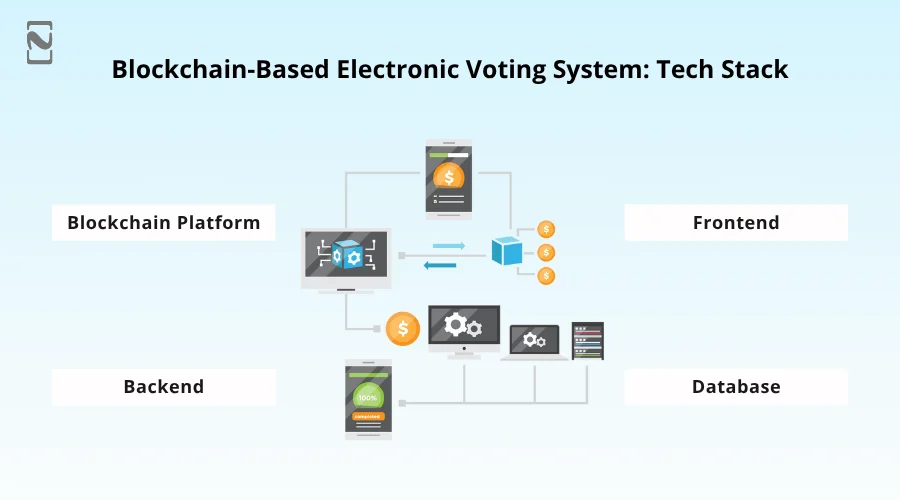
- Blockchain Platform: Ethereum, Hyperledger Fabric, Tezos, or custom blockchain.
- For Frontend: React, Angular, or Flutter for mobile/web apps.
- For Backend: Node.js, Python, or Go.
- Database: IPFS or a traditional database for storing non-sensitive metadata.
4. The Development Phase
We will look into the various development phases of the blockchain voting system:

- Smart Contract Development: Contract creation to handle registration, voting, and result tallying.
- User Authentication System: Integrating a digital identity system that includes eID, biometrics, etc. Additionally, implement 2FA or multifactor authentication.
- Voting Interface: The interface of the voting system must be simple, and there must be a multilingual UI with accessibility features. There must be visual and audio aids for disabled people.
- Vote Casting Process: Before submitting, blockchain allows vote encryption and anonymization. There must be a transaction receipt for each vote or transaction.
Tallying and verifying the vote: Allow real-time tallying without revealing the individual votes. The public must be provided access to anonymized results and verification tools.
5. Testing and Validation
- Unit testing and integration testing: Carry out comprehensive testing of the individual components and the way they interact with the system.
- Security audits and penetration testing: Thorough security audits must be conducted, and penetration testing will allow identification and addressing of the vulnerabilities.
- Performance and scalability testing: The performance of the system must be tested under various loads, so that you know the system can handle a large number of voters and their votes easily.
- User Acceptance Testing (UAT): Include potential users in the testing process of the system and take feedback from them about its usability & functionality.
6. Deployment
- Deploy the system to the production environment: After the testing, deploy the system to the live production environment to conduct the election.
- Maintenance and monitoring: Continuously keep the performance, security, and other issues related to the system under monitoring and update them accordingly.
- Regulatory compliance: The system must comply with the relevant regulations and legal frameworks that govern the electronic voting system.
7. Future Updates and Maintenance
After creating and deploying the blockchain voting system, keeping it updated is also crucial. So, keep the maintenance process going, which will fix bugs from time to time and address vulnerabilities. Then comes the feature upgrade to make e-voting more successful, like integrating AI in political apps.
Core Components of a Blockchain Voting System
You must be thinking, what are the components that make a blockchain electronic voting system work so efficiently? To your knowledge, various components of the blockchain voting system were incorporated in its development.
Here is the list of a few blockchain voting system components that you must know :
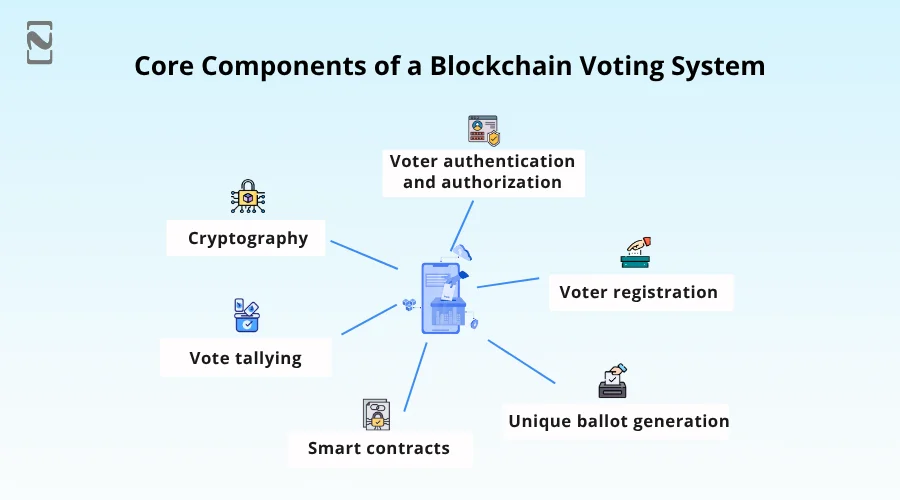
♦ Voter Authentication and Authorization
The modern blockchain voting system ensures that only authentic and authorised voters can register their vote.
Voters can cast their vote through biometric electronic voting systems like fingerprint or face recognition, digital signatures, and decentralised IDs (DIDs). This will help to prevent fraudulent voters from casting their vote and from double-voting.
♦ Voter Registration
Blockchain ensures voters can authentically register themselves following a secure process.
This registration helps to verify the eligibility of the voters, and their databases or information is recorded by the blockchain system. This smart system also uses smart contracts to check or verify the voter’s information automatically against predefined rules.
♦ Unique Ballot Generation
Unlike the traditional voting system, the blockchain-based electronic voting system sends each voter a secure and encrypted ballot.
Each of these ballots ensures uniqueness, and this helps in preventing tampering. Moreover, this system uses Zero-Knowledge Proofs (ZKPs) to verify the eligibility of voters and validate votes, ensuring the privacy of the voters.
♦ Smart Contracts
Smart contracts are one of the crucial components of blockchain-based electronic voting systems. It is a self-running program, automatically handles various aspects of the voting process.
Smart contacts are made to verify voter eligibility, prevent double voting, tally votes, and validate vote integrity, which ensures accuracy and transparency.
♦ Vote Tallying
You just read that smart contracts help in automatic vote tallying, which is another important component of the blockchain voting system.
Automatic vote tallying helps in the secure counting of the votes and provides real-time, transparent results without tampering. Additionally, it allows anyone to tally votes in the network without breaching the privacy of the voters.
♦ Cryptography
A major component of blockchain in the voting system is that it uses cryptography that offers ultimate security.
This component protects the voter’s privacy and their personal information using encryption, digital signatures (like ECDSA), and Zero-Knowledge Proofs (ZKPs). Thus, it gives protection from data tampering.
Real-World Use Cases and Examples of Blockchain-Based Electronic Voting
To clear your doubts about the blockchain-based electronic online voting system, we have come up with some real-world use cases. These use cases will help you get convinced about the advantages of blockchain and develop an online voting system.
We have given two of the best real-world examples of blockchain-based electronic voting :

➤ Estonia’s Online Voting System
Estonia was the first country in the world to hold its national election in 2005 through an online medium. The voting system was dependent upon strong voter identification so that the election would be free from fake voters and voting.
The integration of blockchain technology while creating an online voting system has made the i-voting so safe in Estonia. Furthermore, the blockchain-based voting system in Estonia has made it very convenient for participants to cast their vote.
This system provides incredible transparency, allowing for the monitoring of the vote in real time. Within 30 minutes of casting a vote, each of the participants can verify whether their i-vote reached the electronic ballot.
This ensures that no one can track who voted for whom, and also that no one knows from whom a particular vote came. In the parliamentary election 2023, Estonia witnessed the highest number of voters, 63.7% of the eligible population.
➤ The Pilot Program of West Virginia
West Virginia is the first U.S. state to conduct a pilot program allowing the use of the blockchain voting process. The Secretary of West Virginia saw the problem of the overseas militants casting votes.
The traditional voting system takes away the voting rights of thousands of military personnel. Thus, to remove the barrier of voting for the US militants, the authority develops an online voting system integrating smart blockchain technology.
In 2018, the advanced mobile voting pilot successfully replaced the traditional voting system. The militants in West Virginia downloaded the online voting app and verified themselves with the required ID and biometrics, such as fingerprints.
This has become a safer option for the militants to cast their vote since it can be encrypted, transmitted, and stored only on an immutable blockchain.
Cost and Time Estimate for Developing a Blockchain-Based Electronic Voting System
If you are planning to create an electronic voting system by integrating blockchain technology, it’s an excellent idea to offer voters convenience and security. It is best to delegate this work to an experienced blockchain app development company that will do your work in exchange for an estimated cost.
You must have an idea of how much these companies will charge you and the time taken to create the system. The estimated cost to develop a blockchain-based electronic voting system falls between $20,000 – $150,000.
To complete the development process and create the system, it probably takes 6 to 12 months or more. The cost and time estimation are influenced by various factors of development, which include complexity, team size, location, and others.
Due to these factors, there is a possibility that the time to build an electronic voting system can take more than 12 months, which can increase the cost as well.
Additionally, you can also hire developers who charge by per hour and on a salary. Thus, the cost to hire blockchain developers, as per the hourly rates ranging from $50 to $200 or more, and monthly salaries ranging from $3,000 to $12,000.
Challenges and Their Solutions in Blockchain Voting Implementation
The blockchain voting system is an excellent idea that many countries have taken into consideration. However, since it’s a new technology, many countries are facing several challenges that can lead to problems during the election.
Here we will illustrate 4 of the top challenges along with their solutions :
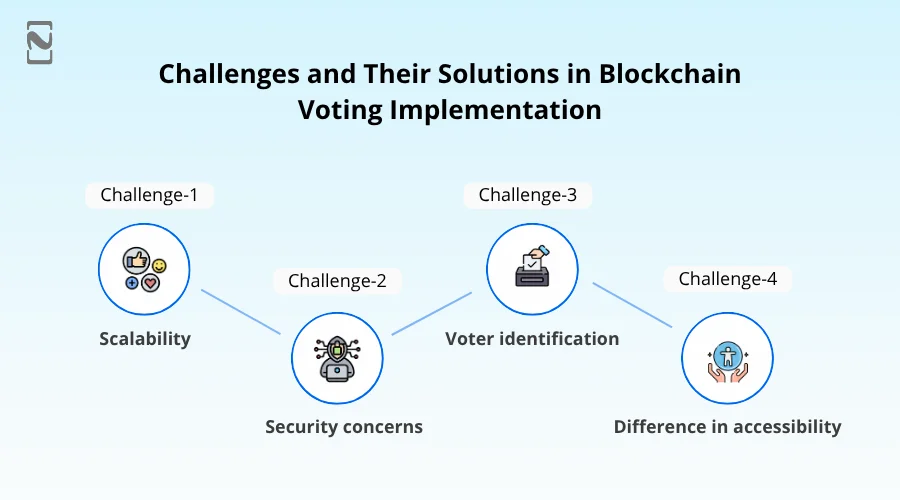
► Scalability
There will be scalability issues for using blockchain technology in the voting system. The public blockchain network uses consensus mechanisms, which can bring limitations in processing large numbers of transactions.
Solution :
To manage a large number of transactions in public elections, it is best to own a hybrid blockchain architecture and layer 2 scaling solutions. You can also implement techniques like sharding to improve scalability. This will divide the network into smaller, more manageable units.
► Security Concerns
Blockchain offers higher security, but it cannot fully protect any system from cyberattacks or manipulation of smart contracts. This can be a huge concern in large-scale elections like national elections involving a big population.
Solution :
You should implement tough measures like rigorous identification and vulnerability mitigation. Additionally, implementing multi-party cryptography and secure smart contract design, altogether, will help in getting security from attacks and manipulation.
► Voter Identification
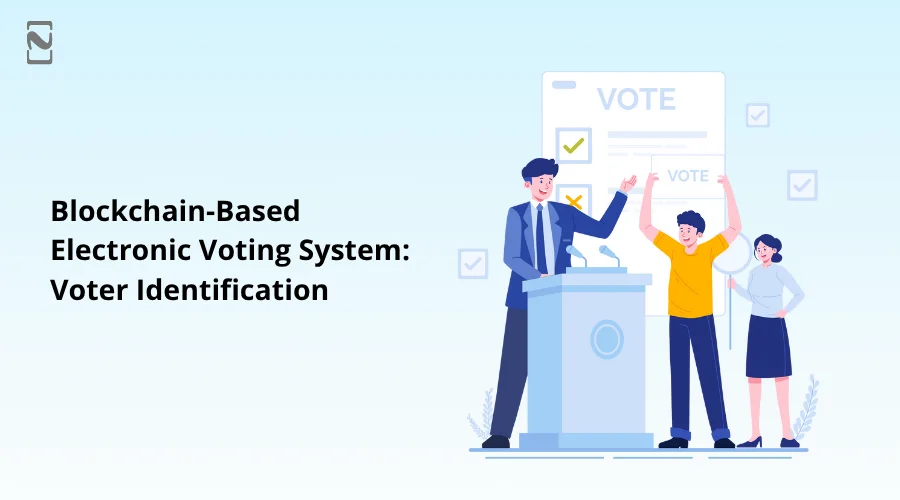
It can sometimes be challenging for blockchain technology to keep the privacy of voters intact in election campaigns. Ensuring the authentication of the voters while at the same time maintaining the voters’ anonymity is an act of balance.
Solution :
The best solution for this is integrating strong biometrics like face recognition systems, retina identification, etc, or the Government. These solutions will boost security, and additionally, the cryptographic signatures will verify voters’ information and prevent fraud.
► Differences in Accessibility
One of the major problems that will arise with implementing blockchain voting systems is unequal accessibility. By this, it means there will be voters who don’t have equal access to technology and the internet, which will hinder their participation in such elections.
Solution :
Authorities must prioritise offering equal technical assistance to voters, which includes offering mobile apps for political parties or web platforms with a user-friendly interface.
Offers participants a multi-channel voting option by combining blockchain with an accessible voting channel, and also organizes digital literacy campaigns.
Partner With Nimble AppGenie to Develop Your Blockchain-Based Electronic Voting System
Thinking of bringing a smart transformation to the traditional election system, which helps even remote voters to cast their vote? Create an online voting system integrating blockchain technology to keep the whole voting process encrypted and secure.
To create the blockchain-based voting system, Nimble AppGenie will be an excellent partner. Other than this, we are the best political app development company that offers a solution to any kind of political app needs.
Conclusion
If we want to shape the future of democracy, then it offers every citizen the opportunity to cast their vote, even those who may not be able to due to distance. Thus, it is a good idea to develop a blockchain-based electronic voting system to help voters step towards a more secure, transparent, and inclusive process.
You know everything about this innovative system that is changing the whole voting system and making it more accessible. You also know how you can create a blockchain-based voting system. It’s time to shape the future of elections with a blockchain-powered voting system.
FAQs

Niketan Sharma, CTO, Nimble AppGenie, is a tech enthusiast with more than a decade of experience in delivering high-value solutions that allow a brand to penetrate the market easily. With a strong hold on mobile app development, he is actively working to help businesses identify the potential of digital transformation by sharing insightful statistics, guides & blogs.
Table of Contents





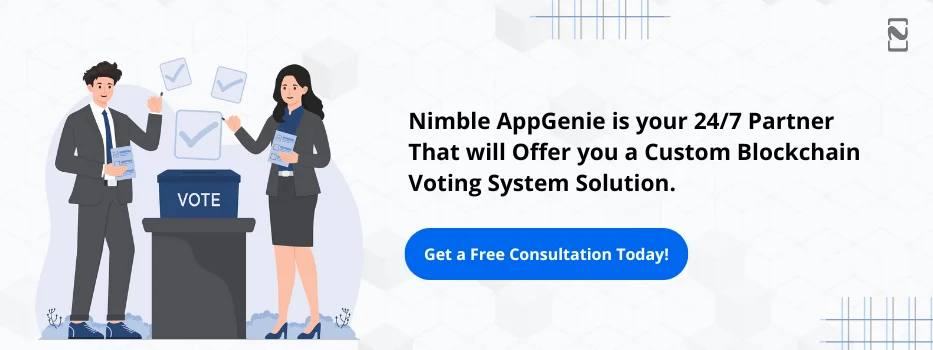
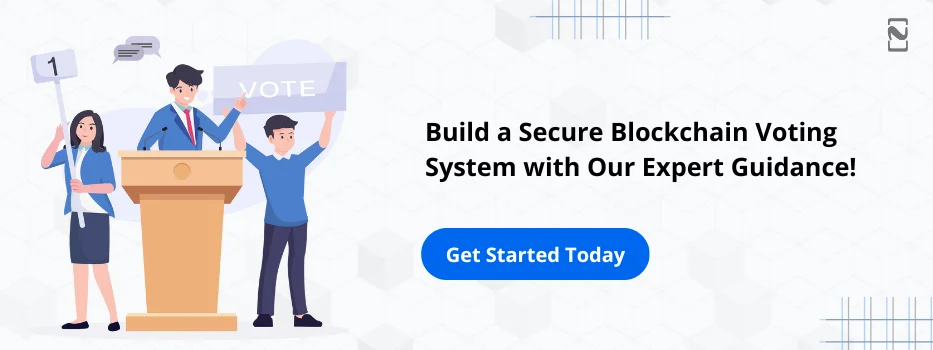
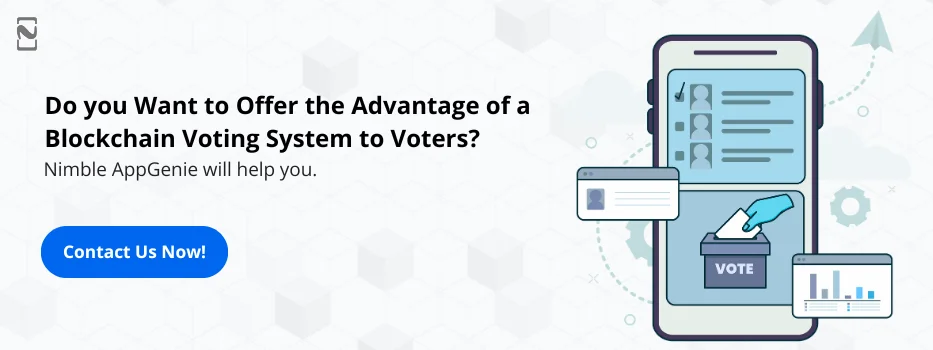
No Comments
Comments are closed.